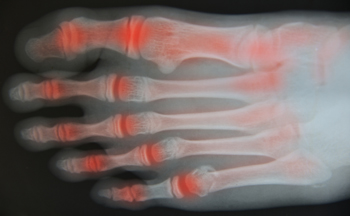
Pickleball is a trending sport that many people enjoy. As with any physical sport, there can be painful foot repercussions if care is not taken while playing pickleball. Two common conditions that can be associated with this activity are plantar fasciitis and Achilles tendinitis. The ligament that runs along the bottom of the foot from the heel to the toes is called the plantar fascia. The fibers from the Achilles tendon run into the plantar fascia. The Achilles tendon attaches to the back of the heel and the plantar fascia on the bottom. The condition known as plantar fasciitis is when the plantar fascia becomes overstretched or sustains micro tears and causes pain in the heel area, especially when first steps are taken after prolonged rest. Achilles tendinitis is often an overuse injury as well. These things can happen after playing pickleball. Stretching the feet and calves, wearing supportive and well-fitting footwear, and resting the affected areas can all help. If the pain you feel in the heel or Achilles tendon continues or worsens, it is suggested that you seek the counsel of a podiatrist. This foot care expert can diagnose and treat foot pain and provide additional suggestions on how you might prevent foot problems while playing pickleball.
Ankle and foot injuries are common among athletes and in many sports. They can be caused by several problems and may be potentially serious. If you are feeling pain or think you were injured in a sporting event or when exercising, consult with one of our podiatrists from Jill Einhorn, DPM and James Einhorn, DPM. Our doctors will assess your condition and provide you with quality foot and ankle treatment.
Common Injuries
The most common injuries that occur in sporting activities include:
Symptoms
Symptoms vary depending upon the injury and in some cases, there may be no symptoms at all. However, in most cases, some form of symptom is experienced. Pain, aching, burning, bruising, tenderness, tightness or stiffness, sensation loss, difficulty moving, and swelling are the most common symptoms.
Treatment
Just as symptoms vary depending upon the injury, so do treatment options. A common treatment method is known as the RICE method. This method involves rest, applying ice, compression and elevating the afflicted foot or ankle. If the injury appears to be more serious, surgery might be required, such as arthroscopic or reconstructive surgery. Lastly, rehabilitation or therapy might be needed to gain full functionality in the afflicted area. Any discomfort experienced by an athlete must be evaluated by a licensed, reputable medical professional.
If you have any questions, please feel free to contact our offices located in Brooklyn and Astoria, NY . We offer the newest diagnostic and treatment technologies for all your foot care needs.

A blister, sometimes referred to as a shoe bite, is an area of the foot that rubs against the shoe and causes pain. The first order of business in preventing blisters is to wear shoes that fit properly. Wearing socks will help provide a cushion between the foot and the shoe. Toe protectors or toe caps can cushion toes from shoes and prevent painful friction. Shoe pads or insoles can also help prevent any abrasive areas. If you have developed a blister, it is important to stop wearing the shoes that caused it and wear open shoes so they can heal. Putting a bandage over the blister while it is healing can help prevent infection. If a blister does not heal, worsens, or becomes infected, it is suggested that you see a podiatrist for a proper diagnosis and treatment.
Blisters are prone to making everyday activities extremely uncomfortable. If your feet are hurting, contact one of our podiatrists of Jill Einhorn, DPM and James Einhorn, DPM. Our doctors can provide the care you need to keep you pain-free and on your feet.
Foot Blisters
Foot blisters develop as a result of constantly wearing tight or ill-fitting footwear. This happens due to the constant rubbing from the shoe, which can often lead to pain.
What Are Foot Blisters?
A foot blister is a small fluid-filled pocket that forms on the upper-most layer of the skin. Blisters are filled with clear fluid and can lead to blood drainage or pus if the area becomes infected.
How Do Blisters Form?
Blisters on the feet are often the result of constant friction of skin and material, usually by shoe rubbing. Walking in sandals, boots, or shoes that don’t fit properly for long periods of time can result in a blister. Having consistent foot moisture and humidity can easily lead to blister formation.
Prevention & Treatment
It is important to properly care for the affected area in order to prevent infection and ease the pain. Do not lance the blister and use a Band-Aid to provide pain relief. Also, be sure to keep your feet dry and wear proper fitting shoes. If you see blood or pus in a blister, seek assistance from a podiatrist.
If you have any questions, please feel free to contact our offices located in Brooklyn and Astoria, NY . We offer the newest diagnostic and treatment technologies for all your foot care needs.

Rheumatoid arthritis, or RA, is an auto-immune disease that causes pain, swelling, and stiffness in the joints. The feet, which contain multiple joints, are often affected by this inflammatory condition. The immune system, instead of protecting the joints, sends antibodies into the lining of the joints causing the tissue surrounding the joint to become inflamed. This results in damage to the bones, tendons, ligaments, and cartilage. Many people are affected by RA, but most develop it between the ages of 40 and 50. Women are three times more likely to have rheumatoid arthritis than men, largely due to hormonal differences. Also, it affects many people who smoke or have a genetic tendency toward the disease. RA causes throbbing and aching pain, and may induce fatigue and fever along with a loss of appetite. Rheumatoid arthritis is not curable, but measures may be taken to reduce the symptoms. If you think you may have RA that is affecting your feet, it is suggested that you consult a podiatrist for treatment options.
Because RA affects more than just your joints, including the joints in your feet and ankles, it is important to seek early diagnosis from your podiatrist if you feel like the pain in your feet might be caused by RA. For more information, contact one of our podiatrists of Jill Einhorn, DPM and James Einhorn, DPM. Our doctors will assist you with all of your podiatric concerns.
What Is Rheumatoid Arthritis?
Rheumatoid Arthritis (RA) is an autoimmune disorder in which the body’s own immune system attacks the membranes surrounding the joints. Inflammation of the lining and eventually the destruction of the joint’s cartilage and bone occur, causing severe pain and immobility.
Rheumatoid Arthritis of the Feet
Although RA usually attacks multiple bones and joints throughout the entire body, almost 90 percent of cases result in pain in the foot or ankle area.
Symptoms
Diagnosis
Quick diagnosis of RA in the feet is important so that the podiatrist can treat the area effectively. Your doctor will ask you about your medical history, occupation, and lifestyle to determine the origin of the condition. Rheumatoid Factor tests help to determine if someone is affected by the disease.
If you have any questions please feel free to contact our offices located in Brooklyn and Astoria, NY . We offer the newest diagnostic and treatment technologies for all your foot and ankle needs.

Pain in the joint of the big toe, termed hallux rigidus, is a form of osteoarthritis caused by the wearing away of cartilage between the base of the big toe and the first metatarsal bone of the foot. This condition often affects runners, as the big toe takes the brunt of the continual pounding with each step. Hallux rigidus often develops in runners between the ages of 30 and 60. Some possible causes include having flat feet or overpronation, which is when the foot rolls inward 15 percent or more with each step. Overtraining, a stubbed toe, gout, a toe deformity, or genetics may also play a role in the development of hallux rigidus. Limited mobility and stiffness in the big toe joint are early symptoms of this disorder. In addition, a runner may experience pain and swelling on top of the big toe. Changing to footwear with a larger toe box and stiffer sole can help relieve the pressure on the big toe. Certain medications may also help. A podiatrist can examine the toe, determine the cause of the joint pain, and offer appropriate treatment solutions. It is suggested that you make an appointment today.
Toe pain can disrupt your daily activities. If you have any concerns, contact one of our podiatrists of Jill Einhorn, DPM and James Einhorn, DPM. Our doctors can provide the care you need to keep you pain-free and on your feet.
What Causes Toe Pain?
Most severe toe pain is caused due to a sports injury, trauma from dropping something heavy on the toe, or bumping into something rigid. Other problems can develop over time for various reasons.
Toe pain can be caused by one or more ailments. The most common include:
When to See a Podiatrist
Diagnosis
In many cases the cause of toe pain is obvious, but in others, a podiatrist may want to use more advanced methods to determine the problem. These can range from simple visual inspections and sensation tests to X-rays and MRI scans. Prior medical history, family medical history, and any recent physical traumatic events will all be taken into consideration for a proper diagnosis.
Treatment
Treatments for toe pain and injuries vary and may include shoe inserts, padding, taping, medicines, injections, and in some cases, surgery. If you believe that you have broken a toe, please see a podiatrist as soon as possible.
If you have any questions please feel free to contact our offices located in Brooklyn and Astoria, NY . We offer the newest diagnostic tools and technology to treat your foot and ankle needs.